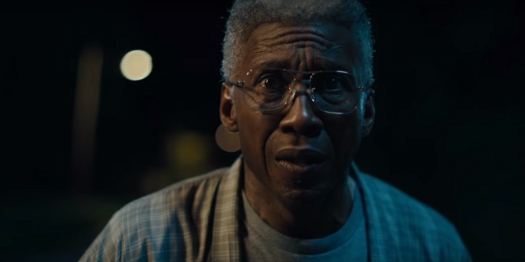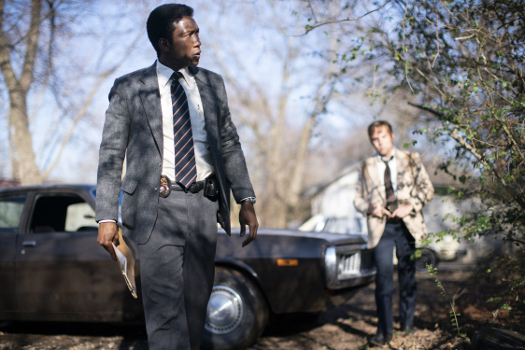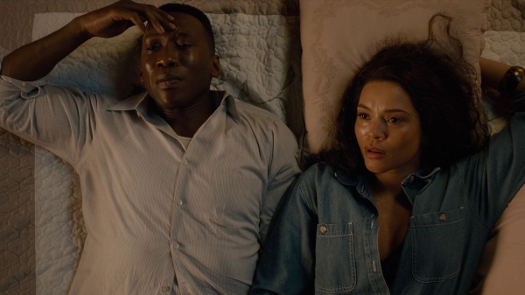The phrasing is strangely redundant, but in case you didn’t know: Time is a flat circle.

True Detective’s Third Season
Sometimes the success or failure of a movie, book, or television show hinges on a short passage. If that small part works, so does the whole; if the crucial bit comes up short, the entire enterprise falls apart.
For me with the third season of creator/writer Nic Pizzolatto’s HBO series True Detective, the moment comes late in the finale when former cop Wayne Hays drives up to the house of a person he strongly suspects is Julie Purcell, who disappeared with her brother Will 35 years ago and has eluded him ever since. Two previous investigations – in 1980 and 1990 – were aborted because there was an easy scapegoat.
More importantly to the narrative, Wayne took himself out of the picture – first because he refused to throw his girlfriend (and future wife) Amelia under the bus, and then because chicken king Edward Hoyt threatened his family. At both points, Wayne was certain the case was unsolved; he didn’t believe the person who killed Will had been identified, and Julie had not been found. Yet he chose to leave things that way.
Now, in 2015, Wayne desperately wants to make things right, and he doggedly goes back over every detail. He will not quit this time, but will his dementia allow him to finish what he started?
There’s a lucky break, and the one-eyed June/Junius – first approached in 1980 – gives it up way too easily. Wayne and his former partner Roland finally reach something of a dead end, a conclusion without satisfaction.
By this point, most of the questions about the case have been answered, but something still nags at Wayne. A few pieces click into place, and he becomes convinced that Julie Purcell is actually alive and well. Even better, he’s confident he knows to whom she’s married and gets her address.
But as he parks his car in front of her house, his memory fails. He’s tucked the address in his pocket, and suddenly he has no idea what he’s doing. He planned to tie up all the loose ends; instead, he asks the woman where he is so that his son can fetch him.
This sequence is essential to the season, and it’s certainly open to interpretation. Some people might believe that Wayne consciously chooses to let Julie be – to not drag her back into this mess – but the text doesn’t support that. He calls his son before he sees her, and he’s alone in his car so there’s no reason for him to feign confusion.
Another reading is cruel – that Wayne’s condition prevents resolution to a mystery that has haunted him for more than three decades. There’s no reason that this couldn’t be the case, and it would be a reasonable and fair – but also sour and shitty – conclusion.
There’s a tantalizing third possibility: Wayne subconsciously sabotages his mission. This idea has a lovely resonance, and I would honestly love to believe in it.

But True Detective is sloppy enough that I can’t. The issue isn’t just the serious problems that plagued the third season: the convoluted structure that seems designed to obfuscate the narrative rather than illuminate Wayne’s condition; a pair of Arkansas State Police investigations that cross a line from inept to ridiculously indifferent; the feint threatening to tie this case to the show’s first season; the nearly silly ease with which the mystery is resolved after 35 years.
I could ignore or get past those if Pizzolatto crafted an ending that sang. That finish begins with this moment, and unfortunately it’s symptomatic of the season’s larger ills.
In this very sequence, Julie’s child Lucy lays eyes on Wayne for the second time in just a few days. She’d previously met him at the convent, and here he is at her house, which feels like a coincidence that would bear mentioning. So why is she silent on the subject?
It’s an admittedly minor point, but it underscores the weirdly under-thought vibe of the scene. If we are truly meant to allow for the possibility that some part of Wayne is making a decision, why wouldn’t his attack come at some point after he sees Julie – when the consequences of what he’s about to do have the human faces of a mother and daughter? This would have been a small change that wouldn’t have precluded the reading of the capricious nature of Wayne’s brain, yet it would have created stronger support to infer generosity in his behavior – a willingness to sacrifice his selfish goal for the peace of a family.
That reading is absolutely tenable, but it would have been far easier to defend with some adjustment. As it stands, Wayne parks, gets confused, calls his son, and then sees the woman he thinks is Julie. It would have been easy – and likely possible even at the editing stage – to re-order that sequence: Wayne parks, sees the woman he thinks is Julie, gets confused, and calls his son. The ambiguity would remain; the difference would be which reading gets the greater evidence.
This reverberates throughout the season. In one scenario, dementia is yet another circumstance that blocks Wayne from completing his task. In the other, he finally puts family – his, and Julie’s – ahead of the case. One of these is merely the frustrating repetition of a pattern; the other is freeing and cathartic without diminishing pain and loss.
And at this fork in the road, True Detective opts for frustration by not more strongly implying a cause-and-effect relationship between Julie Purcell and Wayne’s spell.
Just seven or so minutes later comes another illustration of the problems in True Detective’s third season – and it carries great weight given its placement at the story’s conclusion. Wayne is sitting on the porch with his collected family – a happy ending! – and the camera zooms in to his eye, a transition to a flashback in which (dun dun DUN!) we see his 1980 reconciliation with Amelia. Which would be great, except for the aggressiveness of the zoom and the strangely ominous music that accompanies the shift to that second happy ending … which is followed by the final shots of … Wayne in the Vietnam jungle?
The core idea here is sound: vignettes that show the beginning of his family and what it looks like 35 years later, with Wayne freed of the Purcell case at both ends of the season’s narrative. I could even get on-board with the Vietnam flashback as a reminder that the past is always with us.
But the execution is graceless and tonally confused, and I’m left with the same thought I had after the first season: Nic Pizzolatto desperately needs stronger partners in his show’s conception, writing, and editing. Within his narrow area of interest, he collects and develops a lot of solid parts, but he hasn’t yet been able to satisfyingly assemble or shape them.
Before delving too much further into that, I’ll stress that we should accept as a given that True Detective’s mysteries are not the sort that the audience is permitted to solve. The letdown of the first season should have taught us to watch for character and mood and tension, and to not worry much about the plot. (I skipped the second season, by the way.)
So I was content enough watching Mahershala Ali’s fantastically divided performance as Wayne, and happy to get caught up in the portraits of the character’s relationships with Carmen Ejogo’s Amelia and Stephen Dorff’s Roland. There was even giggly pleasure in Dorff’s 1980 and 2015 hair, and his 2015 paunch. I noted the repeated emphasis of the chicken plant, but I gave up early trying to put the pieces of the mystery together. So when the season finale solved the case with information that was new to both us and the detectives – and was unavailable until the one-eyed guy was ready to unburden himself in 2015 – I shrugged. Forget it, Jake. It’s True Detective.
Even so, Pizzolatto requires us to swallow a lot of bullshit to make that work. Wayne and Roland give up their hot 1980 lead because the one-eyed guy – who knows everything that happened – is good at riling up the people in his neighborhood. In 1990, the fingerprints of a girl missing for 10 years are found at a drug store, and she calls the police hotline, but the state police stop looking for her because … ummmm … her father “kills himself.”
In both situations, we’re expected to believe that political expediency wins despite one dead body for two missing children. In 1990, we’re expected to believe that political expediency wins despite one dead body for two missing children and evidence that the other body is still walking around breathing and saying she just wants to be left alone. That’s a high-level suspension-of-disbelief requirement, built on a hilariously cynical foundation that viewers will casually accept such deep corruption in law-enforcement without any suggestion of something more sinister than convenience.
Oh, but there’s the sinister suggestion in 1990 of a pedophile kidnapping ring, and there are our Season One detectives in the newspaper, and maybe this is all connected in a fucking Yellow King, spaghetti-monster True Detective Universe.
Just kidding, says Pizzolatto. This is nothing more than your garden-variety bereaved chicken-fortune heiress accidentally killing a boy and buying the daughter to drug and stash away in a pink dungeon. Bet you didn’t see that coming!
So the mystery is dumb, and Pizzolatto kept the solution safely locked away until the finale. Let’s be forgiving and say that it never really mattered that much.
We’re left with Wayne, his deteriorating memory, his obsession with the case, and his relationships with Roland and Amelia. (Secondarily, we have Wayne’s children.) These are undoubtedly the strongest parts of the season, with Ali and Ejogo especially good in their scenes together.

Maybe there’s a case to be made that the core story of True Detective’s third season is Wayne’s family generally, and especially his relationship with Amelia. But I can’t get there.
The first problem for me is Pizzolatto’s chosen structure. By restricting the story to the times of the three investigations, he can show little in the relationship between Wayne and Amelia beyond the conflict. In 1980 and 1990, a dead boy and a missing girl were between them, and Wayne was almost always a dick. I still can’t figure out what Amelia liked in him in the first place, and I wonder how their marriage worked for so long, given that we likely envision Wayne resentful and seething for a decade in his public-information desk job, lacking any means to crack the case that forever eats at him.
Pizzolatto could have easily employed the messy nature of memory to fill those holes, but it looks like he has no genuine interest in the relationships. He treats them as background elements to the mystery – so much so that he couldn’t even be bothered to say how Amelia died or why Wayne’s daughter was so absent in 2015. (These bits were apparently cut for time, which proves the point.)
What remains for me, then, are Wayne’s dementia and obsession – the players in what is simultaneously a war and a race. It’s a great story conceit and structural skeleton, but to really work it has two requirements. First, the memories of 1980 and 1990 should flow naturally from 2015 Wayne, as if the television show were following his train of thought. Second, his failing memory should be an essential element – a substantial barrier to Wayne finally closing the case.
On the first issue, I honestly don’t know whether the show clears the bar. It might, or it might just be an easy way for Pizzolatto to dispense and withhold information without seeming overly manipulative, or it might be a lazy and random mess, or some combination of the three. I’m not going to watch the season again to decide; for reasons I’ve already mentioned, it doesn’t seem worth the trouble, despite rich and plentiful raw material.
On the second issue, I’ve already laid some groundwork, but it cannot be overstated: Because Wayne could not solve the case without Junius’ 2015 guilty conscience, his faulty memory is basically of no consequence. (And “solve” is way too strong a word given how things happen.) If our primary character were of fully sound mind in 2015, the final investigation could have played out exactly the same up to the point that he pulls up to Julie’s house.
And that means Pizzolatto has put in a ton of work – and forced the audience to do a ton of work – solely for that climactic moment, which he then botches. After this long and winding road, we can see it as a punchline, or we can find in it a moment of grace. In either case, it’s the only point at which Wayne’s dementia is genuinely relevant.
But the sequence remains maddeningly opaque, and our options for interpretation are both problematic.
One is of-a-piece with the case that will never die and the show’s nihilistic outlook, but it’s ironic and mean. If the ever-looming destructive threat of Wayne’s illness was being saved for precisely this moment, when it would obliterate his quest and our investment in seeing it properly concluded, why bother?
The other possibility is seductive, but the evidence for it is scanter than it should be, and it’s further undercut by the messiness of what preceded and what follows. I truly wish that somewhere in the writing, shooting, and/or editing process, somebody had restructured this moment so that it could better support the idea of Wayne’s intent, conscious or subconscious.
The best we have to latch onto is Wayne’s vision of his dead wife. “You write the story,” she tells him. “It’s important to know how you want it to end.”
She’s speaking to us, too – the audience, the final arbiters of what we’ve seen. And I wouldn’t have put eight hours into watching this if I didn’t want it to end well. Despite the season’s substantial problems, Nic Pizzolatto had the moment to salvage it. It was right there, in the car with Wayne. Suggest the choice, diminish chance.
Alas …. it’s True Detective.

